by Lisa Cooke | Jun 14, 2017 | 01 What's New, Genealogy Gems Podcast
The Genealogy Gems Podcast
Episode #204
with Lisa Louise Cooke
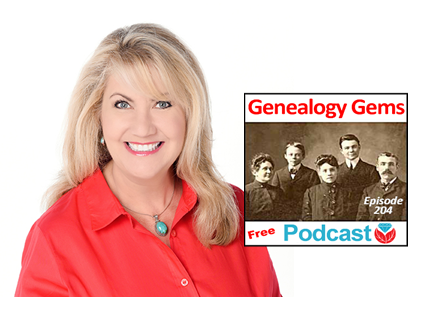
Canadian expert Dave Obee shares the story of the Canadian home children tips on newspaper research. Also in this episode:
New site features at MyHeritage, including improved DNA ethnicity analysis (it’s free?upload your DNA!);
An excerpt from the Genealogy Gems Book Club interview with Fannie Flagg about The Whole Town’s Talking?and a great summer reading idea;
A detailed get-started guide to British Isles research: Terminology and census/civil BMD record tips from Kate Eakman at Legacy Tree Genealogists
Why so many weddings are traditionally held in June.
[display_podcast]
Download the show notes
NEWS: DNA AND CATALOG UPDATES AT MYHERITAGE
MyHeritage.com: DNA ethnicity estimate updates and new collection Catalog
View an example of the new ethnicity analysis presentation here: https://vimeo.com/218348730/51174e0b49
3 top uses for the new MyHeritage catalog (with additional details and commentary)
MyHeritage Quick Reference Guide (Newly-updated in 2017)
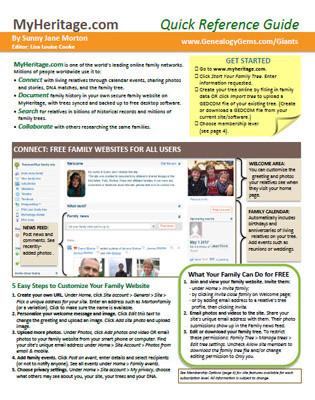
Genealogy Giants: Comparing the 4 Major Websites. This brand new, comprehensive guide helps you answer the question, “Which genealogy websites should I use?”

MAILBOX: BOOK CLUB COMMENTS


Visit the book club here.
Companion video recommendations:
Genealogy Journey: Running Away to Home video (click here to see the book)
“You Came and Saved Us” video with author Chris Cleave, Everyone Brave is Forgiven
Alan Cumming on Who Do You Think You Are? Episode summary
Not My Father’s Son by Alan Cumming
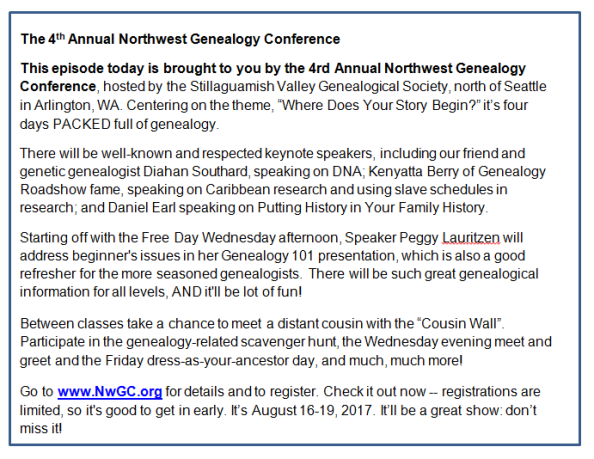
For more information: www.nwgc.org

Lisa Louise Cooke uses and recommends RootsMagic family history software. From within RootsMagic, you can search historical records on FamilySearch.org, Findmypast.com and MyHeritage.com. In the works: soon RootsMagic will be fully integrated with Ancestry.com, too: you’ll be able to sync your RootsMagic trees with your Ancestry.com trees and search records on the site.

Learn more or sign up for Backblaze here.
Keep your family history research, photos, tree software files, videos and all other computer files safely backed up with Backblaze, the official cloud-based computer backup system for Lisa Louise Cooke’s Genealogy Gems. Learn more at http://www.backblaze.com/.
INTERVIEW: DAVE OBEE

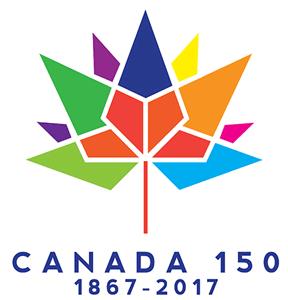
Continuing our celebration of Canada’s 150th birthday!
Dave Obee is an internationally-renowned Canadian journalist, historian and genealogist. Dave is a columnist for Internet Genealogy and Your Genealogy Today (formerly Family Chronicle). Dave has also written about family history for Canada’s History and Your Family Tree in the United Kingdom.
Put Dave’s books on your shelf – you can get them here.
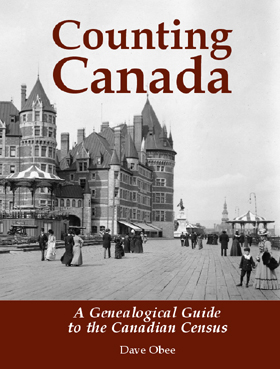
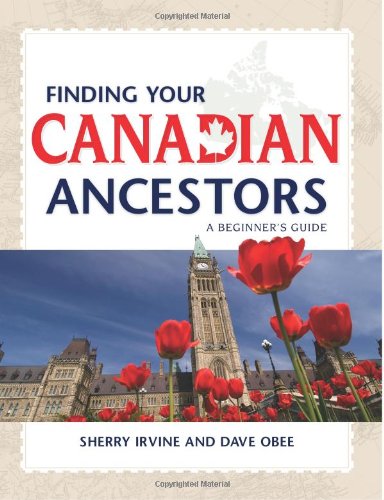
Finding Your Canadian Ancestors: A Beginner’s Guide
Counting Canada: A Genealogical Guide to the Canadian Census
Destination Canada: A Genealogical Guide to Immigration Records
Making the News: A Times Columnist Look at 150 Years of History
Canada research tips:
Look in newspapers for ship crossings, notable people sailing, approximate numbers of passengers etc.
Don’t just rely on search engines for digitized newspapers. Browse the papers where you find some hits.
Canada Home Children: Watch and Learn
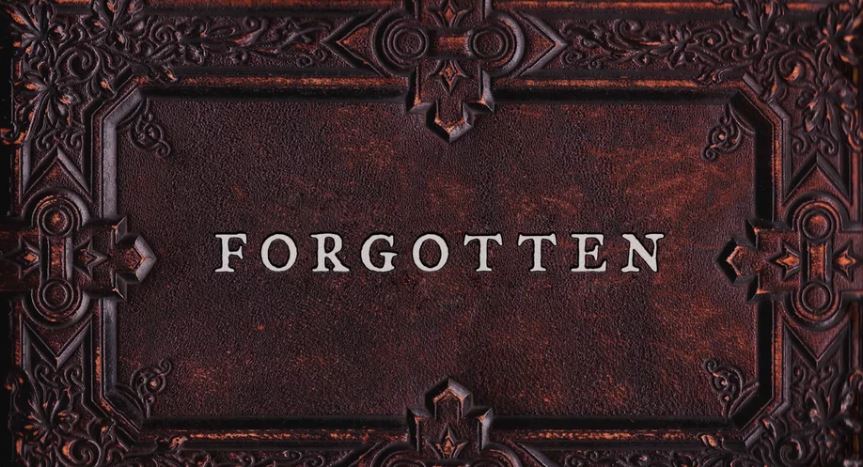
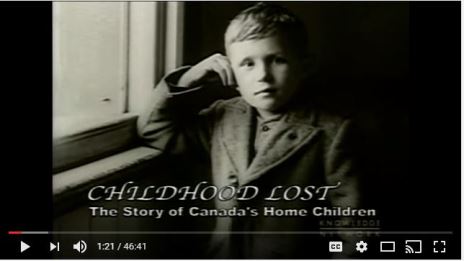
Forgotten, an award-winning documentary (watch the trailer here)
Childhood Lost: The Story of Canada’s Home Children documentary (watch it on YouTube)
LEGACY TREE GEM: ENGLISH PARISH RECORDS
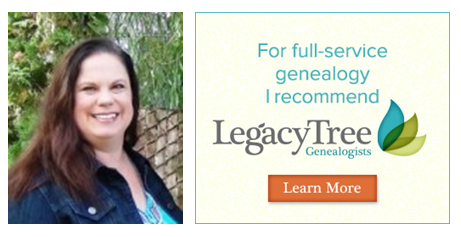
Visit Legacy Tree Genealogists: http://www.legacytree.com/genealogygems
Read a companion blog post on English parish records, with several image examples and links to the resources Kate Eakman recommends.
Legacy Tree Genealogists provides expert genealogy research service that works with your research goals, budget and schedule. The Legacy Tree Discovery package offers 3.5 hours of preliminary analysis and research recommendations: a great choice if you’ve hit a brick wall in your research and could use some expert guidance.
GENEALOGY GEMS BOOK CLUB: FANNIE FLAGG INTERVIEW
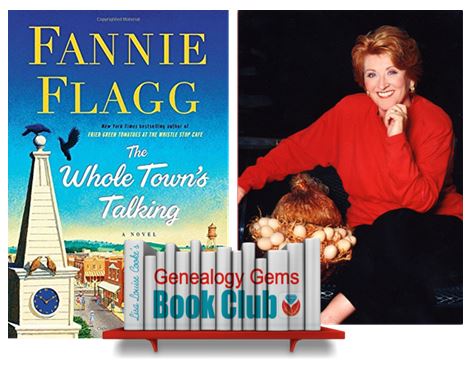
The Whole Town’s Talking by Fannie Flagg
Genealogy Gems Premium website members may hear this entire conversation in the upcoming Genealogy Gems Premium Podcast episode #148.
BONUS CONTENT for Genealogy Gems App Users

LINK IMAGE TO: http://test.lisalouisecooke.com/get-app/
If you’re listening through the Genealogy Gems app, your bonus audio content for this episode comes from Melissa Barker, the Archive Lady, in honor of International Archives Day on June 9. The Genealogy Gems app is FREE in Google Play and is only $2.99 for Windows, iPhone and iPad users

Start creating fabulous, irresistible videos about your family history with Animoto.com. You don’t need special video-editing skills: just drag and drop your photos and videos, pick a layout and music, add a little text and voila! You’ve got an awesome video! Try this out for yourself at Animoto.com.

MyHeritage.com is the place to make connections with relatives overseas, particularly with those who may still live in your ancestral homeland. Click here to see what MyHeritage can do for you: it’s free to get started.
PROFILE AMERICA: June Weddings

PRODUCTION CREDITS
Lisa Louise Cooke, Host and Producer
Sunny Morton, Editor
Diahan Southard, Your DNA Guide, Content Contributor
Lacey Cooke, Service Manager
Vienna Thomas, Associate Producer
Check out this new episode!
by Lisa Cooke | May 24, 2017 | 01 What's New, Book Club, Writing Family History
Wish you could write family history like a master storyteller? Take a page from best-selling novelist Fannie Flagg’s fiction-writing. These three steps will help you bring your ancestors’ stories to life, so that their stories become as compelling to your relatives as they are to you.
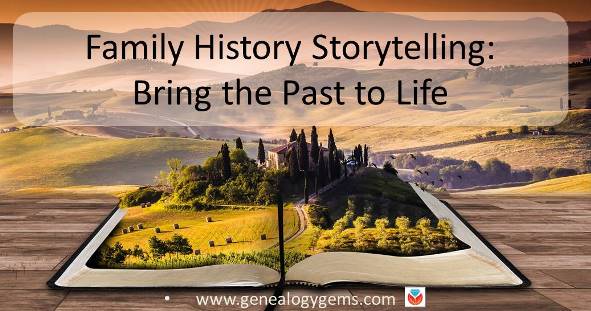
 Powerful storytellers create characters so vivid, we miss them when we finish reading. They take us into worlds that become just as real. Experiencing their stories changes us, even if just subtly. Fannie Flagg is one of this generation’s great storytellers, and she does all three of these things in The Whole Town’s Talking, our current Genealogy Gems Book Club title. The book is an excellent example for family history storytellers who want to bring their own ancestors to life in narratives that captivate and change their own loved ones.
Powerful storytellers create characters so vivid, we miss them when we finish reading. They take us into worlds that become just as real. Experiencing their stories changes us, even if just subtly. Fannie Flagg is one of this generation’s great storytellers, and she does all three of these things in The Whole Town’s Talking, our current Genealogy Gems Book Club title. The book is an excellent example for family history storytellers who want to bring their own ancestors to life in narratives that captivate and change their own loved ones.
3 Keys to Amazing (Family History) Storytelling
1. Create vivid characters.
Lordor Nordstrom seems an unlikely hero at the beginning of The Whole Town’s Talking. He’s a 30-something single Swede who has come to the heartland of the U.S. to build a life. He’s a quiet man, a hard worker who starts a dairy farm. But then he starts to stand a little straighter and attract people his direction because he has a dream of what his world should look like. He places ads in newspapers and convinces other Swedes to settle nearby. Swedetown is born around him. We start to see that his quiet determination and vision are accomplishing great things for himself and others. Then this quiet, unprepossessing fellow gets up the nerve to place another newspaper ad:
Swedish man of 37 looking for Swedish lady for marriage. I have a house and cows.
But when he gets a response from a “24-year old Swedish lady of the Lutheran faith,” he starts to sweat and stammer and second-guess himself. He gets his picture taken: he looks like a hayseed. He gets a haircut: the bowl-cut style was a bad idea. But he persists despite feeling totally unready for the sweet, refined young lady who, after more stammering and shyness, eventually and very willingly becomes his bride.
NOW YOU TRY IT:
Think of an ancestor you want to write about. What do you know about him or her? Do you know she was born in a tiny village, or that he lost three siblings at once in a cholera epidemic? Do you know he was the first in the family to learn to read? Or that her husband disappeared when she had three children and one on the way?
You have to pay close attention to historical records to notice those kinds of details. You also have to think about and make connections between different events. That’s how you’ll realize those three siblings all died at the same time, and that not long after, he left school to take care of his family. Then you can start to create a “character” out of those scrawled names and details in all those old records.
Write down 5-10 specific details you know about an ancestor. If you can’t think of any, start scrutinizing historical records. Note physical details in military records or passport applications. Did he naturalize? Could she read English? How old were they when they married? Construct a timeline and make connections: “Oh my, he lost his wife in childbirth at the same time his father died. Suddenly he was caring for both his 82-year old mother and a newborn!”
2. Paint the historical backdrop.
Fannie places the story of Lordor and his want-ad bride Katrina in the beautiful but largely unknown American Midwest. The future of that country was as unwritten as the future of this couple. Gradually a small immigrant town comes into being, content to be its modest, friendly self. Fannie tells us about Main Street, the local businesses, the churches, the town’s main families and how they are related. We get just enough gossip to feel we know the people. In fact, we can imagine ourselves stopping in to gossip over a fence or attend a church potluck. The things that happen to the characters are more imaginable because we can picture the setting.
The story of Lordor and Katrina doesn’t just unfold against the settling of the Midwest frontier, though. As the narrator, Fannie Flagg puts Lordor and Katrina’s marriage into historical context, too. They were like many mail-order couples during a period of great change and movement in American history, she says:
On both sides, it was a desperate game of chance. But, surprisingly, many marriages did work out, and the results helped populate the country with a hardy and adventurous stock. People were willing to travel anywhere, sacrifice anything, to own their own land, to be free and be independent.
Though Fannie is writing fiction, she’s writing within a real historical world that she researches and loves to bring to life.
NOW YOU TRY IT:
We, too, can paint detailed portraits of our ancestors’ lives on a broader canvas of history. Do some reading about the history of the town and region. Look for trends or patterns or events that would specifically have affected your ancestors, based on where they lived, their ethnic or religious identity, financial status, gender, etc.
Click here to read more tips for learning the history surrounding your ancestors’ lives: Tell Your Ancestor’s Story: Use Social History for Genealogy
3. Give readers something to think about, or a reason this story matters.
The title of this story–The Whole Town’s Talking– doesn’t just refer to neighborly gossip on the streets and church pews of Swedetown (which eventually becomes Elmwood Springs). The key to this story is what happens at the town cemetery, on a hill overlooking the town on land donated by Lordor. After town residents die, we meet them again when they “wake up” in their cemetery plots. They still have their memories and personalities. They banter with each other and fawn over loved ones who come to visit their graves. They keep up on town gossip and their grandchildren and changes in society as best they can.
What I took away from this delightful scenario is the idea that family love persists past the grave. That memories of loved ones we honor at a cemetery may just be powerful enough to keep them there and, in a sense, alive. That they continue on.
NOW YOU TRY IT:
It’s not always easy to find a running theme, meaning, or message in a life you’ve researched. After all, you don’t see the whole thing. And most lives don’t unfold along a single theme. But if you’re excited enough to write about an ancestor, something about their story moves you. What is it? Try to put your finger on it. And then write about it, like this short passage about my own ancestor:
“What I see in Thomas Selby’s life is a man who never stopped moving or building. The challenges and opportunities of the frontier were to him an open door, beckoning to him. He started life with no apparent advantages, given away by his mother. That didn’t seem to dim his confidence. He was apparently uneducated, yet he studied law and argued a case before the Ohio supreme court. He bought up land and established friendships in southeast Ohio, then lit out for the California Gold Rush. He failed dramatically: the shipload of flour he took to sell the Goldrushers spoiled and he apparently had to walk all the way home. It took him seven years. But being broke didn’t stop him from buying homestead land in Missouri on the way home and immediately relocating his family. Eventually he settled there and spread his energies into creating enterprises: a flourishing farm, a general store, and judgeship.
I also see a man who seems to have totally excluded his wife and children when making decisions about the future. It was a common attitude for his time. But I think of him striding up to his yard on an evening seven years after disappearing, ragged and worn from the road. Family lore says he saw his wife come to the door with a gun and yelled, “Don’t shoot, Huldy, it’s me!” But if I were Huldy, finding out it was him–and that he’d just decided to move me into the wilderness without even consulting me–might just have made me pull the trigger.”
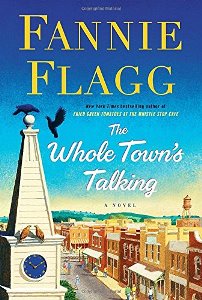 For more storytelling inspiration, curl up with Fannie’s Flagg’s novel The Whole Town’s Talking–and then tune in to the upcoming Genealogy Gems Premium Podcast episode 148, in which Fannie herself joins us on the show. (Premium website membership required–but we play an excerpt in the free Genealogy Gems Podcast episode #204.
For more storytelling inspiration, curl up with Fannie’s Flagg’s novel The Whole Town’s Talking–and then tune in to the upcoming Genealogy Gems Premium Podcast episode 148, in which Fannie herself joins us on the show. (Premium website membership required–but we play an excerpt in the free Genealogy Gems Podcast episode #204.
by Lisa Cooke | Apr 26, 2017 | 01 What's New, Book Club
Beloved American novelist Fannie Flagg is our newest Genealogy Gems Book Club author! Nobody can spin a story quite like she can, as she proves in The Whole Town’s Talking. You’ll love the stories of her funny, foibled characters in this intergenerational saga of a small, fictional town in the American Midwest.

 The Whole Town’s Talking is best-selling author Fannie Flagg’s newest novel. A Swedish immigrant plants roots in the American Midwest and advertises in Swedish-American newspapers for a bride and neighbors to settle the land. Thus begins the town of Elmwood Springs, Missouri, the setting of several of Fannie’s previous novels.
The Whole Town’s Talking is best-selling author Fannie Flagg’s newest novel. A Swedish immigrant plants roots in the American Midwest and advertises in Swedish-American newspapers for a bride and neighbors to settle the land. Thus begins the town of Elmwood Springs, Missouri, the setting of several of Fannie’s previous novels.
Over several decades, descendants of the original settlers populate the town. As residents die, they appear again among their neighborly dead in the local cemetery. They continue to gossip and chatter and, occasionally, suffer. (One poor man finds himself buried between his first wife and his second, who didn’t get along in life and still don’t.)
Much-loved characters from other Fannie Flagg novels appear in The Whole Town’s Talking (or at least their ancestors do). Swedish immigrant Lordor Nordstrom is an ancestor of young Dena Nordstrom from Welcome to the World, Baby Girl! Among his neighbors are the fascinating families of spunky Elner Shimfissle, her nervous niece Norma and Poor Tot from Can’t Wait to Get to Heaven. We even hear echoes of Neighbor Dorothy, the famous housewife with the radio show in Standing in the Rainbow.
In The Whole Town’s Talking, Fannie Flagg captures the broad sweep of Midwestern history while staying grounded in the stories of everyday people. It’s easy to fall in love with the folks from Elmwood Springs, to cheer them on in their struggles and successes, to match-make their children, to laugh along with them (and sometimes at them, bless their hearts). Their foibles and quirks likely will remind you of many on your family tree. That’s all the better, given Fannie’s premise that these folks continue to live on and take an interest in our lives. To a genealogist who falls more in love with her ancestors the more she knows buy medication online forum about them, I find this a pretty irresistible notion.
Special thanks to Genealogy Gems Premium member Richard in Sacramento CA, who recommended The Whole Town’s Talking! He loved “the time span, the family relations and the discussions as folks entered the cemetery and the town changed.”
There’s more of Fannie Flagg to love….
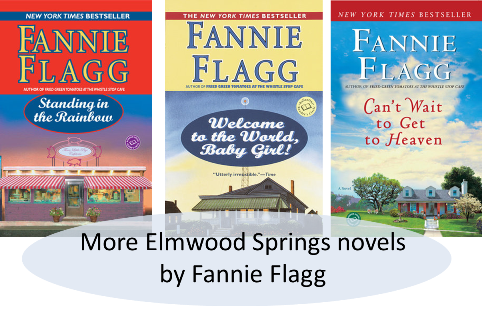 In fact, Richard has read all of Fannie Flagg’s books. He thinks several of them would be “valuable reads” for the Genealogy Gems Book Club.” I agree wholeheartedly! I’m a longtime Fannie Flagg fan, ever since I saw the movie version of her classic novel Fried Green Tomatoes at the Whistle Stop Cafe.
In fact, Richard has read all of Fannie Flagg’s books. He thinks several of them would be “valuable reads” for the Genealogy Gems Book Club.” I agree wholeheartedly! I’m a longtime Fannie Flagg fan, ever since I saw the movie version of her classic novel Fried Green Tomatoes at the Whistle Stop Cafe.
When you finish The Whole Town’s Talking, consider picking up one of the other Elmwood Springs stories already mentioned: Welcome to the World, Baby Girl! or Can’t Wait to Get to Heaven or Standing in the Rainbow.
 I can’t resist recommending Fannie’s second most-recent novel, too: The All-Girl Filling Station’s Last Reunion. The main character is Sookie, a lovable Southern woman (she is Dena Nordstrom’s best friend in Welcome to the World, Baby Girl!) Sookie discovers she is not who she thinks she is. After a huge family secret is revealed, she questions everything she has ever believed about herself and her family. Sookie launches a secret search for a new sense of identity under the nose of her loving but domineering mother. She navigates the effects of her discoveries on her sense of identity, her marriage and her daughters’ lives. It’s funny, it’s poignant–and along the way she learns about a fascinating and little-known chapter in American history.
I can’t resist recommending Fannie’s second most-recent novel, too: The All-Girl Filling Station’s Last Reunion. The main character is Sookie, a lovable Southern woman (she is Dena Nordstrom’s best friend in Welcome to the World, Baby Girl!) Sookie discovers she is not who she thinks she is. After a huge family secret is revealed, she questions everything she has ever believed about herself and her family. Sookie launches a secret search for a new sense of identity under the nose of her loving but domineering mother. She navigates the effects of her discoveries on her sense of identity, her marriage and her daughters’ lives. It’s funny, it’s poignant–and along the way she learns about a fascinating and little-known chapter in American history.
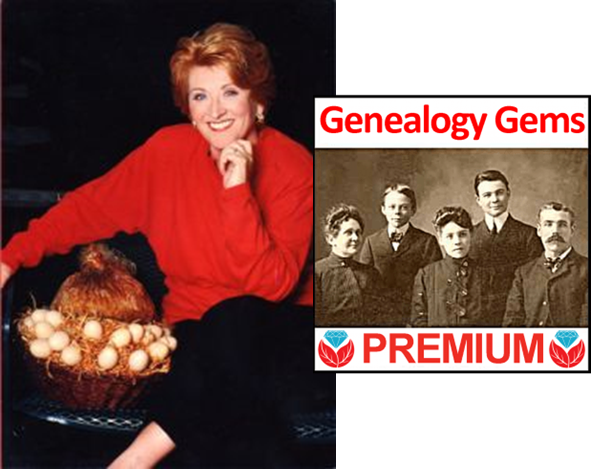 I hope you enjoy Miss Fannie Flagg as much as Richard and I do! The immortal storyteller herself will join us on the Genealogy Gems Premium Podcast in two months. So go read The Whole Town’s Talking! (And if you’re not a Genealogy Gems Premium website member, consider becoming one. A teaser clip from our conversation will appear in the free Genealogy Gems Podcast episode #204, but to hear the whole thing, you’ll need access to the Genealogy Gems Premium Podcast episode #148.
I hope you enjoy Miss Fannie Flagg as much as Richard and I do! The immortal storyteller herself will join us on the Genealogy Gems Premium Podcast in two months. So go read The Whole Town’s Talking! (And if you’re not a Genealogy Gems Premium website member, consider becoming one. A teaser clip from our conversation will appear in the free Genealogy Gems Podcast episode #204, but to hear the whole thing, you’ll need access to the Genealogy Gems Premium Podcast episode #148.























 In fact, Richard has read all of Fannie Flagg’s books. He thinks several of them would be “valuable reads” for the Genealogy Gems Book Club.” I agree wholeheartedly! I’m a longtime Fannie Flagg fan, ever since I saw the movie version of her classic novel
In fact, Richard has read all of Fannie Flagg’s books. He thinks several of them would be “valuable reads” for the Genealogy Gems Book Club.” I agree wholeheartedly! I’m a longtime Fannie Flagg fan, ever since I saw the movie version of her classic novel 
 I hope you enjoy Miss Fannie Flagg as much as Richard and I do! The immortal storyteller herself will join us on the Genealogy Gems Premium Podcast in two months. So go read
I hope you enjoy Miss Fannie Flagg as much as Richard and I do! The immortal storyteller herself will join us on the Genealogy Gems Premium Podcast in two months. So go read 


